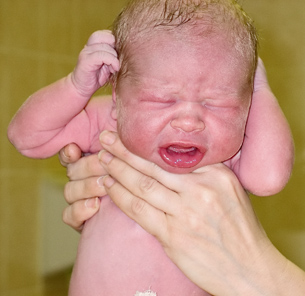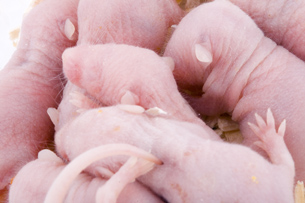Module 8
1. Module 8
1.38. Lesson 10
Module 8—Populations, Individuals, and Gene Pools
Lesson 10—Growth Patterns
 Get Focused
Get Focused

© Oleg Kozlov/45426/Fotolia

© Werg/6014942/Fotolia
Exponential Versus Logistic Growth Patterns
From your work in Unit B, consider how many offspring a woman might be capable of having in her lifetime. There are approximately 30 years from the first ovulation in puberty until menopause. Ovulation occurs every 28 days, so there are about 12 opportunities a year to produce an egg. That’s 30 years × 12 ovulations/year = 360 ovulations or opportunities to reproduce in a woman’s lifetime.
However, there are nine months of gestation for the offspring and, if the mother is nursing, she may not ovulate for a few months after the birth. Assuming she’s capable of having one child each year for those 30 years, each woman has the potential to produce 30 offspring in her 80-year lifespan. This number doesn’t take factors such as multiple births, miscarriages, missed ovulations, malnutrition, maternal and child mortality, sterility, or other factors into consideration. However, it is still a very impressive figure.
With close to seven billion people on the planet and approximately half of them female, you can see how human population size could significantly increase if conditions were favourable! The human population growth graph on page 733 of your textbook may convince you that it already has. Humans, however, do not typically produce 30 offspring, and they reproduce at a much slower rate than their biotic potential might permit.
As impressive as the biotic potential of humans is, it pales in comparison to a typical female field mouse. At one month of age, the female mouse is capable of breeding and having a litter of ten young after a gestation period of 20 days. After giving birth, the female mouse ovulates and can breed again 24 hours later. Even though she may only live five months in the wild due to predation, the biotic potential of a wild mouse is staggering: four months (120 days) of breeding, producing one litter of ten pups every 20 days = a potential to produce 60 offspring in her five-month lifespan. Achieving this potential is common in mice. This amazing reproductive potential or fecundity reminds us of how necessary predators (like coyote, fox, hawks, the domestic cat) and, possibly, poisons (like Warfarin) are in controlling mouse populations.
Biotic potential is one of many factors responsible for how fast a population grows. The different rates of growth seen in various species produce two different growth patterns that have been observed in nature. In this lesson you will be introduced to both patterns.
In this lesson the following focusing questions will be examined:
- What are the different types of population growth patterns?
- How do growth patterns illustrate these types of changes over time?
 Module 8: Lesson 10 Assignment
Module 8: Lesson 10 Assignment
Download a copy of the Module 8: Lesson 10 Assignment to your computer now. You will receive further instructions on how to complete this assignment later in the lesson.
In addition to your lesson work, any summary notes, sample problems, diagrams, charts, or tables should be stored in the course folder for your teacher’s feedback and your study as you prepare for exams.
You must decide what to do with the questions that are not marked by the teacher. Remember that these questions provide you with the practice and feedback that you need to successfully complete this course. You should record the answers to all of the questions and place those answers in your course folder.
Remember, you also have the option of trying additional questions from the textbook for further practice. Consult with your teacher for the answers to these questions. The Key will also provide you with many Diploma Exam-style multiple-choice, numeric-response, and written-response questions that will be an excellent review of the module. Practising your responses to these types of questions is good preparation for the Diploma Exam.